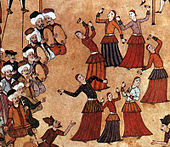Ahmed III.
Ahmed III. (* 1673 ; † July 1, 1736 in Istanbul ) was Sultan of the Ottoman Empire from 1703 to 1730 .
Life
Ahmed was a son of Mehmed IV and ascended the throne in 1703 after his brother Mustafa II had been deposed. In the face of the threatening attitude of Russia , he developed relations with England .
In 1709 he granted Charles XII. of Sweden after its defeat at Poltava in the Ottoman Empire took refuge. Forced to war by Russia, he came closer to a decisive victory against his northern competitor than any other Ottoman ruler before or after him, since his Grand Vizier Baltaji Mehmed Pasha was able to completely surround the Russian troops on their Prut campaign near the Prut (1711). In the Peace of the Prut , Russia undertook to return Azov to the Ottoman Empire, destroy several previously built fortresses and not interfere in the matter of the Poles or the Cossacks in the future . The dissatisfaction with the mildness of these conditions was so strong in Constantinople that the war almost broke out again.
In 1715 the Morea on the Peloponnese was wrested from the Republic of Venice . Austria allied itself with Venice and started war against the Ottomans. The siege of the island of Corfu was repulsed by Venice in the summer of 1716 and Belgrade fell into the hands of the Habsburgs in 1717. Through the mediation of England and Holland, the Peace of Passarowitz (Serbian: Požarevac ) was concluded in 1718 , in which the Ottoman Empire kept the Morea peninsula, which had been taken from the Venetians, but lost the Banat , northern Serbia and little Wallachia to Austria.
A war with Persia ended in disaster that led to the Patrona-Halil uprising of the Janissaries , who deposed Ahmed in September 1730. He died in captivity in 1736.
The period from 1703 to 1730 became known as the Tulip Time ( Lale devrı ). It was a time of cultural prosperity, especially miniature painting . An illustrated catalog of tulips was published in 1725. In 1727 Ahmed İbrahim Müteferrika allowed the establishment of a printing press with Arabic letters, which had been forbidden until then. Ahmet III. owned tulip meadows on the summer pastures in Spil Dağı above Manisa , which were widely admired. and imported garden tulips from Holland
See also
literature
- Ferenc Majoros, Bernd Rill: The Ottoman Empire 1300-1922. The story of a great power . Marix, Wiesbaden 2004, ISBN 3-937715-25-8 .
- Josef Matuz: The Ottoman Empire. Baseline of its history . 4th edition. Scientific Book Society, Darmstadt 2006, ISBN 3-534-20020-9 .
- Nicolae Iorga : History of the Ottoman Empire. Depicted according to the sources. 5 volumes, Verlag Perthes, Gotha 1908–1913, reprinted Frankfurt / Main 1990.
- Gabriel Effendi Noradounghian : Recueil d'actes internationaux de l'Empire Ottoman 1300-1789. Tome I. Paris, Neufchâtel 1897. Reprint: Kraus, Nendeln 1978, ISBN 3-262-00527-4 .
Web links
- http://www.tuerkenbeute.de/kun/kun_bio/Ahmet3_de.php Badisches Landesmuseum, Karlsruhe: Ahmed III.
- Tripota - Trier portrait database
Individual evidence
- ↑ John H. Harvey 1976, Turkey as a Source of Garden Plants. Garden History 4/3, 22nd JSTOR 1586521
- ↑ Liz Dobbs, Tulip. Quadrille, London 2004, 6
| predecessor | Office | successor |
|---|---|---|
| Mustafa II. |
Sultan and Caliph of the Ottoman Empire 1703–1730 |
Mahmud I. |
| personal data | |
|---|---|
| SURNAME | Ahmed III. |
| ALTERNATIVE NAMES | Ahmet III. |
| BRIEF DESCRIPTION | Sultan of the Ottoman Empire (1703-1730) |
| DATE OF BIRTH | 1673 |
| DATE OF DEATH | July 1, 1736 |
| Place of death | Constantinople |

